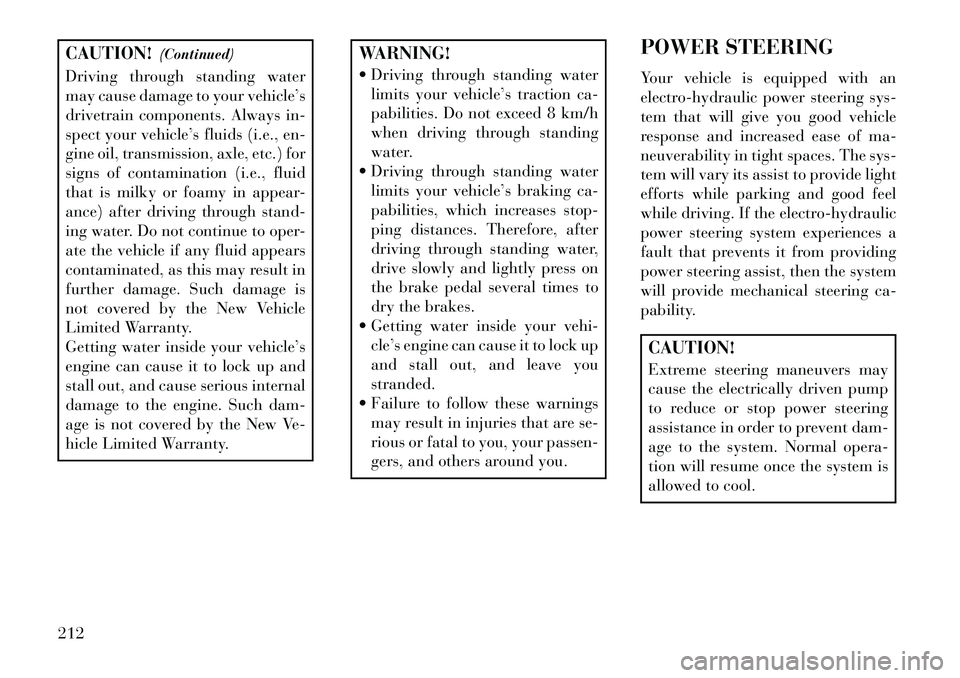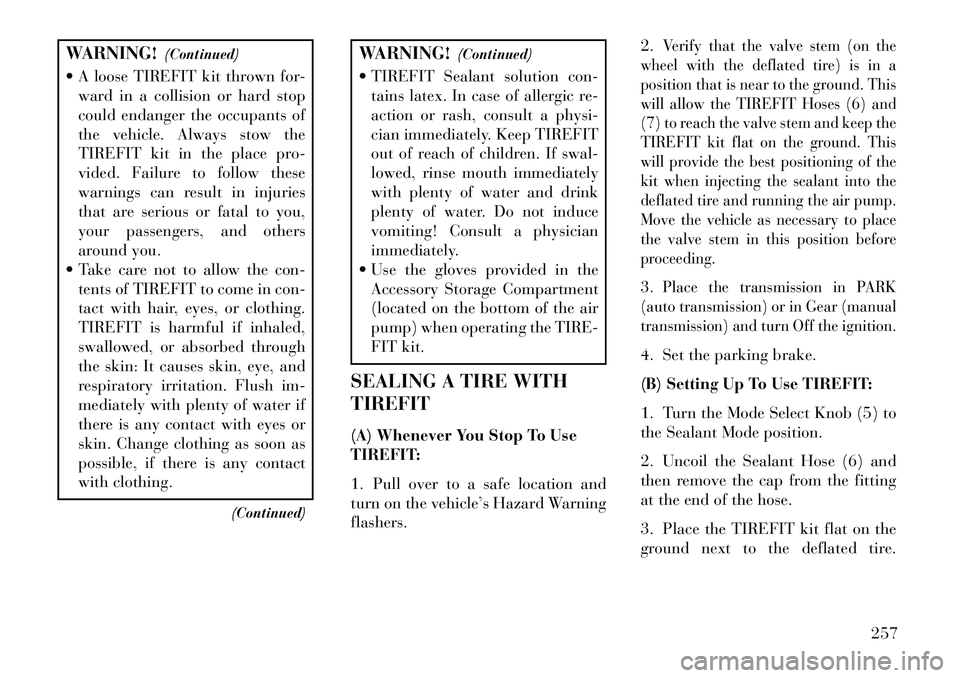water pump Lancia Thema 2013 Owner handbook (in English)
[x] Cancel search | Manufacturer: LANCIA, Model Year: 2013, Model line: Thema, Model: Lancia Thema 2013Pages: 336, PDF Size: 3.87 MB
Page 218 of 336

CAUTION!(Continued)
Driving through standing water
may cause damage to your vehicle’s
drivetrain components. Always in-
spect your vehicle’s fluids (i.e., en-
gine oil, transmission, axle, etc.) for
signs of contamination (i.e., fluid
that is milky or foamy in appear-
ance) after driving through stand-
ing water. Do not continue to oper-
ate the vehicle if any fluid appears
contaminated, as this may result in
further damage. Such damage is
not covered by the New Vehicle
Limited Warranty.
Getting water inside your vehicle’s
engine can cause it to lock up and
stall out, and cause serious internal
damage to the engine. Such dam-
age is not covered by the New Ve-
hicle Limited Warranty.
WARNING!
Driving through standing water limits your vehicle’s traction ca-
pabilities. Do not exceed 8 km/h
when driving through standing
water.
Driving through standing water
limits your vehicle’s braking ca-
pabilities, which increases stop-
ping distances. Therefore, after
driving through standing water,
drive slowly and lightly press on
the brake pedal several times to
dry the brakes.
Getting water inside your vehi-
cle’s engine can cause it to lock up
and stall out, and leave you
stranded.
Failure to follow these warnings may result in injuries that are se-
rious or fatal to you, your passen-
gers, and others around you. POWER STEERING
Your vehicle is equipped with an
electro-hydraulic power steering sys-
tem that will give you good vehicle
response and increased ease of ma-
neuverability in tight spaces. The sys-
tem will vary its assist to provide light
efforts while parking and good feel
while driving. If the electro-hydraulic
power steering system experiences a
fault that prevents it from providing
power steering assist, then the system
will provide mechanical steering ca-
pability.
CAUTION!
Extreme steering maneuvers may
cause the electrically driven pump
to reduce or stop power steering
assistance in order to prevent dam-
age to the system. Normal opera-
tion will resume once the system is
allowed to cool.
212
Page 262 of 336

Using The Power Button
Push and release the Power
Button (4) once to turn On
the TIREFIT kit. Push and
release the Power Button (4)
again to turn Off the TIREFIT kit.
Using The Deflation Button
Press the Deflation But-
ton (2) to reduce the air
pressure in the tire if it be-
comes over-inflated.
TIREFIT USAGE
PRECAUTIONS
Replace the TIREFIT Sealant Bottle (1) and Sealant Hose (6)
prior to the expiration date (printed
on the bottle label) to assure opti-
mum operation of the system. Refer
to “Sealing a Tire with TIREFIT”
section (F) “Sealant Bottle and
Hose Replacement”.
The Sealant Bottle (1) and Sealant Hose (6) are a one tire application
use. After each use, always replace
these components immediately at
an authorized dealer. When the TIREFIT sealant is in a
liquid form, clean water, and a
damp cloth will remove the mate-
rial from the vehicle or tire and
wheel components. Once the seal-
ant dries, it can easily be peeled off
and properly discarded.
For optimum performance, make sure the valve stem on the wheel is
free of debris before connecting the
TIREFIT kit.
You can use the TIREFIT air pump to inflate bicycle tires. The kit also
comes with two needles, located in
the Accessory Storage Compart-
ment (on the bottom of the air
pump) for inflating sport balls,
rafts, or similar inflatable items.
However, use only the Air Pump
Hose (7) and make sure the Mode
Select Knob (5) is in the Air Mode
when inflating such items to avoid
injecting sealant into them. The
TIREFIT Sealant is only intended
to seal punctures less than 6 mm
diameter in the tread of your
vehicle. Do not lift or carry the TIREFIT kit
by the hoses.
WARNING!
Do not attempt to seal a tire onthe side of the vehicle close to
traffic. Pull far enough off the
road to avoid the danger of being
hit when using the TIREFIT kit.
Do not use TIREFIT or drive the
vehicle under the following cir-
cumstances:– If the puncture in the tire tread is approximately 6 mm or
larger.
– If the tire has any sidewall damage.
– If the tire has any damage from
driving with extremely low tire
pressure.
– If the tire has any damage from
driving on a flat tire.
– If the wheel has any damage.
– If you are unsure of the condi- tion of the tire or the wheel.
Keep TIREFIT away from open flame or heat source.
(Continued)
256
Page 263 of 336

WARNING!(Continued)
A loose TIREFIT kit thrown for- ward in a collision or hard stop
could endanger the occupants of
the vehicle. Always stow the
TIREFIT kit in the place pro-
vided. Failure to follow these
warnings can result in injuries
that are serious or fatal to you,
your passengers, and others
around you.
Take care not to allow the con- tents of TIREFIT to come in con-
tact with hair, eyes, or clothing.
TIREFIT is harmful if inhaled,
swallowed, or absorbed through
the skin: It causes skin, eye, and
respiratory irritation. Flush im-
mediately with plenty of water if
there is any contact with eyes or
skin. Change clothing as soon as
possible, if there is any contact
with clothing.
(Continued)
WARNING!(Continued)
TIREFIT Sealant solution con- tains latex. In case of allergic re-
action or rash, consult a physi-
cian immediately. Keep TIREFIT
out of reach of children. If swal-
lowed, rinse mouth immediately
with plenty of water and drink
plenty of water. Do not induce
vomiting! Consult a physician
immediately.
Use the gloves provided in the Accessory Storage Compartment
(located on the bottom of the air
pump) when operating the TIRE-
FIT kit.
SEALING A TIRE WITH
TIREFIT
(A) Whenever You Stop To Use
TIREFIT:
1. Pull over to a safe location and
turn on the vehicle’s Hazard Warning
flashers. 2.
Verify that the valve stem (on the
wheel with the deflated tire) is in a
position that is near to the ground. This
will allow the TIREFIT Hoses (6) and
(7) to reach the valve stem and keep the
TIREFIT kit flat on the ground. This
will provide the best positioning of the
kit when injecting the sealant into the
deflated tire and running the air pump.
Move the vehicle as necessary to place
the valve stem in this position before
proceeding.
3.
Place the transmission in PARK
(auto transmission) or in Gear (manual
transmission) and turn Off the ignition.
4. Set the parking brake.
(B) Setting Up To Use TIREFIT:
1. Turn the Mode Select Knob (5) to
the Sealant Mode position.
2. Uncoil the Sealant Hose (6) and
then remove the cap from the fitting
at the end of the hose.
3. Place the TIREFIT kit flat on the
ground next to the deflated tire.
257